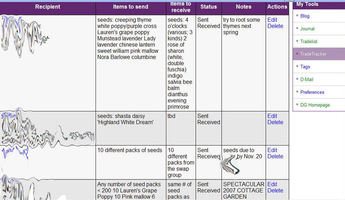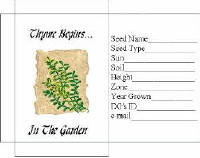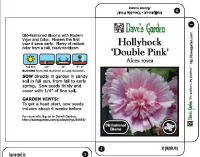





There are many reasons to visit Dave's Garden. I know a lot of members first joined for the ability to search PlantFiles, the largest plant database in the world. I did. I subscribed when I got frustrated with the limited daily searches available as a free member.  Now, for me, a day without DG is like a day without sunshine. Others like to have access to people who love the same plants they do or who live in the same area of the country and have similar growing conditions. But Dave's Garden was originally created for the purpose of trading seeds with other members and this remains an integral part of DG today.
Now, for me, a day without DG is like a day without sunshine. Others like to have access to people who love the same plants they do or who live in the same area of the country and have similar growing conditions. But Dave's Garden was originally created for the purpose of trading seeds with other members and this remains an integral part of DG today.
When you get involved in multiple trades--and you will--your TradeTracker is a tool you can't live without. It includes the who/what/when/where and will also send an automatic notice to the other trader when the trade is marked as sent or received. You can see a small example of mine at right. I have blocked out the name/addresses for privacy, but when you enter a member's DG name, the real name and address will fill in automatically if it is in the address exchange. In the Trade Lists you will find every DG trader's haves and wants. It is searchable, so you are almost sure to find someone who has what you are looking for. Make an offer...you never know what will come of it. Both of these tools are integrated with PlantFiles, so you have instant access to further information about the plant/seed in question. If you go to the Seed Trading Discussion Forum or Group Trades, Swaps, and Round Robins Discussion Forum [1] at any given time, you may find requests for a very specific variety of seed, offers of free seeds for postage, the beginnings of a 'round robin'[2], or a sign-up for a 'hostess' type exchange. By this I mean the kind where everybody sends their seeds to the hostess and he/she returns different seeds to the participant. This is the kind of trade I want to talk about, although some of what I'll discuss could apply to any kind of trades.
In the Trade Lists you will find every DG trader's haves and wants. It is searchable, so you are almost sure to find someone who has what you are looking for. Make an offer...you never know what will come of it. Both of these tools are integrated with PlantFiles, so you have instant access to further information about the plant/seed in question. If you go to the Seed Trading Discussion Forum or Group Trades, Swaps, and Round Robins Discussion Forum [1] at any given time, you may find requests for a very specific variety of seed, offers of free seeds for postage, the beginnings of a 'round robin'[2], or a sign-up for a 'hostess' type exchange. By this I mean the kind where everybody sends their seeds to the hostess and he/she returns different seeds to the participant. This is the kind of trade I want to talk about, although some of what I'll discuss could apply to any kind of trades.
I decided to write this article after some newer members stated they were reluctant to join in the seed swaps because the hostesses or other participants sounded "mean" and "everyone sounds mad and it doesn't look fun." Well, I want to assure you that seed trading is absolutely FUN! And very rarely is anyone mean. If they are, just don't trade with them again. The majority of the folks here at DG are generous, helpful and anything but mean.
I also had inexperienced traders tell me they were embarrassed to join a swap because they didn't know as much as everybody else. Listen up here! This is the way to learn. We were all new once. Embarrassment?? The best way to find out how much fun it is? Sign up! But don't sign up for something that requires more seeds than you have. Frequently, there are swaps where you send in ten packs of seeds and get back ten different packs; that's a good place to start. If you need larger amounts of seed, and you don't have it from your own garden, one of our members has suggested buying bulk seeds from Hazzard's Wholesale Seeds or another seed wholesaler where you can buy larger packs and divide them. Just be honest about the source of the seeds and don't represent them as being from your garden. There is nothing wrong with trading purchased seeds unless the swap is limited to homegrown seeds. I started a little survey over in the Seed Trading forum to ask about the traders' pet peeves. Some things the veteran traders thought were obvious and had been discussed ad nauseam. But would a new trader know about them? Probably not, and when they are bombarded with all of the requirements it can seem overwhelming if they don't know the reasons for them. New traders have to believe me, it gets easier and is better for everyone if you pay attention to these ten pointers. It's not that hard, honestly. Here they are, in no particular order: A generous person sent me some Chinese lantern seeds. That's all it said. It was not a trade. This person sent me a nice packet of a bunch of different seed they thought I would like, just to be nice. If you search PlantFiles for 'Chinese Lantern', you get Abutilon (which I know as Flowering Maple), Erica blenna (a heath), Hibiscus schizopetalus (aka Fringed Rosemallow), Physalis alkekengi (THIS WAS IT!!) and several others. I just wanted to know for sure what I was planting; does it need sun or shade, how tall will it be, what color are the blooms, etc, etc? I finally asked him (see #4). By the way, I think I may have some lanterns this year...they bloomed! Here are a couple of other funny things that came out of that thread. One of our members received a pack of seeds in a trade labelled "real pretty flowers planted next to the garage." Now what's she to do with them if she hasn't got a garage? While we were chatting about seed trading problems I managed to spill a dish of seeds I was sorting. Another member shared this with her husband who suggested I leave them where they fell and just water the carpet. (I suspect there is enough dirt down there to nourish them for some time.) The discussion also yielded an excellent tip: add a few grains of rice to a packet and the seeds won't stick to the plastic bag. Here are just a few of the seed packet designs that are available free at DG. The first one is the Dave's Garden 'official' seed packet. The second is a pretty herb design. The last one is specific for 'Double Pink' Hollyhocks. A member has designed a large number of packets, many of them for specific varieties. Check these out at Seedpackets. Notice that all of them have foldover flaps so there will be no chance of seeds sticking to tape at the edges. Are we having fun yet? Sure we are! I never had as much fun as I did last winter when I spent every waking hour packing, sorting, counting, cleaning and mailing seeds. [4] I joined a couple of very BIG swaps and traded hundreds of packs. It was a blast. DON'T DO IT!! It's insanity. But DO join a swap or two that you can manage. Follow the rules. Know the excitement of getting those bubble envelopes in your mailbox. Try some plants that you never heard of. Look through the spring catalogs and say to yourself, "I don't need to buy this plant. I have seeds for it from the swap." Know that your seeds are making plants that will be growing happily in gardens who-knows-where... maybe even my garden. Some Additional Reading: Seed Trading Etiquette=Please don't make me get out the magnifying glass by Catherine Smith (aka doccat) What's in a Name? The Importance of Knowing and Using Latin Names for Plants by Jill M. Nicolaus (aka critterologist) Plant & Seed Trading Primer [1] Please note: Seed Trading Discussion Forum and Group Trades, Swaps, and Round Robins Discussion Forum are available to paid subscribers only [2] A 'round robin' is a swap in which the hostess starts a box with his/her seeds and sends it to the first participant on the swap list. That person takes some seeds and adds an equal number of his/her own seeds, then sends it on to the next member on the list. And so on until it reaches the hostess again, who should have brand new seeds in the box. [3] Here are some sites that will help you identify the seeds for a large number of common garden plants. Seeds of Cultivated Flowers, Front Range Seed Analysts (nice clear photos) Plant profiles, seed pods, seeds, craftygardener.ca (some common flowers) Family Guide for Fruits and Seeds, USDA Agricultural Research Service (very detailed scientific information) [4] See my article on last winter's seed trades: A Tale of Some Travelling Seeds  No, no, NO!!! Not allowed!
No, no, NO!!! Not allowed!  Here is a quote from a member (with permission) from a thread I started discussing seed swaps, ".... my first trade ever. i asked her to tell me step by step how to do it. i was so scared. it all went well though in spite of me. and so it shall with other newbies. newbies just need to say they have never prepared seeds or plants for mailing. truly most of us remember the fear of those first trades and our hearts are just immediately softened when somebody says that." (Note: a "newbie" is someone new to a particular endeavor, in this case, seed trading.)
Here is a quote from a member (with permission) from a thread I started discussing seed swaps, ".... my first trade ever. i asked her to tell me step by step how to do it. i was so scared. it all went well though in spite of me. and so it shall with other newbies. newbies just need to say they have never prepared seeds or plants for mailing. truly most of us remember the fear of those first trades and our hearts are just immediately softened when somebody says that." (Note: a "newbie" is someone new to a particular endeavor, in this case, seed trading.)  It's not hard. You can look up your plants in PlantFiles and get the Latin name. Once you look it up, you'll know it for next time. If you really want to trade seeds, this step will make it easier for yourself and the other traders. Several traders--brand new and experienced--questioned why they should include the Latin name, stating the receiver of the seeds could look up the name just as easily if they wanted to. Here's a classic example to demonstrate why that approach won't work:
It's not hard. You can look up your plants in PlantFiles and get the Latin name. Once you look it up, you'll know it for next time. If you really want to trade seeds, this step will make it easier for yourself and the other traders. Several traders--brand new and experienced--questioned why they should include the Latin name, stating the receiver of the seeds could look up the name just as easily if they wanted to. Here's a classic example to demonstrate why that approach won't work: There are many ways to pack seeds. Use small plastic zipper bags, paper coin envelopes, glassine stamp envelopes (these are used for tiny seeds and then slipped inside another packet), or homemade packets. For mailing, use a bubble envelope (that's the 'B' in SASBE) so the seeds don't get crushed by the machines at the post office. One last thought: follow the rules set by the hostess, to the letter. If you don't understand something, ask. Nobody minds a question and there's usually a lot of chat about the swap. If you can't do that, you can always stick to one-on-one trades where you make your own rules. In the photo at left, A and B are both the same small zipper bag, but one has a label inside, the other has a sticker on the outside. C is a homemade packet with a computer-generated image of the flower and a lot more information on the back. A creative person made D, a slip of paper with all the data, folded over (the attached) glassine envelope with the seeds inside. The coin envelope (E) has a pasted-on, computer-printed label, but would be perfect for those who don't have a computer and need to hand write.
There are many ways to pack seeds. Use small plastic zipper bags, paper coin envelopes, glassine stamp envelopes (these are used for tiny seeds and then slipped inside another packet), or homemade packets. For mailing, use a bubble envelope (that's the 'B' in SASBE) so the seeds don't get crushed by the machines at the post office. One last thought: follow the rules set by the hostess, to the letter. If you don't understand something, ask. Nobody minds a question and there's usually a lot of chat about the swap. If you can't do that, you can always stick to one-on-one trades where you make your own rules. In the photo at left, A and B are both the same small zipper bag, but one has a label inside, the other has a sticker on the outside. C is a homemade packet with a computer-generated image of the flower and a lot more information on the back. A creative person made D, a slip of paper with all the data, folded over (the attached) glassine envelope with the seeds inside. The coin envelope (E) has a pasted-on, computer-printed label, but would be perfect for those who don't have a computer and need to hand write.


 These are my labels. I stick them on the plastic zipper bags. They are nicer than some, less elaborate then others. I use my name label on everything I send to a DG member, so I keep that separate. The specific plant labels are computerized so I can print as many as I need. I just have to edit them for each different plant (Microsoft Word). I have also added the height of the plant and, for perennials, the hardiness zone. Often I put a small photo of the plant inside the bag with the seeds. This is easy for me. You can work out what is comfortable for you.
These are my labels. I stick them on the plastic zipper bags. They are nicer than some, less elaborate then others. I use my name label on everything I send to a DG member, so I keep that separate. The specific plant labels are computerized so I can print as many as I need. I just have to edit them for each different plant (Microsoft Word). I have also added the height of the plant and, for perennials, the hardiness zone. Often I put a small photo of the plant inside the bag with the seeds. This is easy for me. You can work out what is comfortable for you.
Copyright © www.100flowers.win Botanic Garden All Rights Reserved